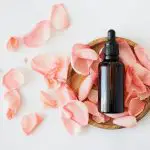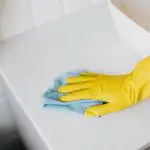If you're looking for an adhesive that can weave a strong bond with fabrics, you've likely heard about E6000. In the world of fabric adhesives, E6000 is often touted as a top contender. But is it truly the best choice for your fabric projects?
This concise analysis will delve into the efficacy of E6000 adhesive for fabrics, weighing its advantages and drawbacks, comparing it to alternative adhesives, and offering expert tips for successful application.
Whether you're a seasoned seamstress or a crafting connoisseur, mastering the art of fabric adhesion is essential. So, let's unravel the intricacies of E6000 and determine if it truly stands out as the premier adhesive for fabrics.
Key Takeaways
- E6000 is a versatile adhesive suitable for bonding various materials, including fabric, metal, and wood.
- E6000 offers a versatile adhesive option for different fabric types, creating a strong and durable bond that withstands frequent washing and wear.
- Excessive application of E6000 can stiffen the texture of the fabric and leave behind visible residue, potentially compromising the comfort and appearance of garments or projects.
- Considering alternative adhesives specifically designed for fabric applications may help avoid these issues.
Understanding E6000 Adhesive
If you're working with fabrics, E6000 adhesive offers a reliable and versatile option for bonding various materials together. Understanding its chemical composition is crucial for grasping its long-term durability.
E6000 is a unique adhesive known for its exceptional strength and flexibility. Its chemical composition includes a mix of industrial-strength bonding agents, making it suitable for a wide range of materials, including fabric, metal, wood, and more.
One of the key benefits of using E6000 adhesive is its ability to withstand environmental factors such as temperature changes and moisture, making it ideal for fabric projects that may be exposed to varying conditions. Additionally, its long-term durability ensures that bonded materials stay securely attached over time.
However, it's important to note that E6000 adhesive has a strong odor and requires proper ventilation when being used. Additionally, some users may find its thick consistency challenging to work with for intricate fabric projects.
Understanding these aspects of E6000 adhesive is essential for making informed decisions when working with fabrics.
Pros of Using E6000 on Fabrics
When it comes to using E6000 on fabrics, you'll find that it offers a versatile adhesive option that can be used on a wide range of fabric types. Its ability to create a strong and durable bond makes it a reliable choice for various fabric-related projects, from crafting to repairs.
The pros of using E6000 on fabrics extend to its versatility and the lasting hold it provides, making it a go-to adhesive for fabric applications.
Versatile Fabric Adhesive Option
The E6000 adhesive is a versatile option for fabric, offering a strong and durable bond for a wide range of projects.
When it comes to fabric crafting, E6000 stands out in adhesive comparison due to its ability to bond to various fabrics, including leather, denim, and canvas, making it an ideal choice for different types of fabric projects.
Its flexibility allows for comfortable wear in garments and accessories, while its washability ensures the longevity of the bond even after multiple washes.
Additionally, E6000 dries clear, maintaining the aesthetic appeal of the fabric without leaving any visible residue. Its resistance to heat and cold further enhances its durability, making it suitable for diverse fabric applications, from everyday repairs to intricate fabric creations.
Strong and Durable Bond
For strong and durable fabric bonds, E6000 adhesive offers a reliable solution. Its effectiveness in creating long-term fabric bonding is unmatched. E6000 is designed to provide a strong and durable bond on various types of fabrics, ensuring that your projects withstand the test of time.
The adhesive creates a flexible and weatherproof bond, making it ideal for both indoor and outdoor fabric applications. Its ability to adhere to a wide range of fabrics, including leather, canvas, and denim, showcases its versatility and reliability.
When using E6000 for fabric bonding, you can trust that your creations will maintain their integrity, even with frequent use and exposure to different environmental conditions. With E6000, you can have confidence in the longevity and durability of your fabric projects.
Cons of Using E6000 on Fabrics
When using E6000 on fabrics, keep in mind that it can stiffen the texture of the fabric, making it less pliable and potentially affecting the overall feel and drape of the material.
Additionally, E6000 may leave behind visible residue on the fabric, which could be difficult to remove, especially on delicate or intricate designs.
These factors should be carefully considered before using E6000 as an adhesive for fabrics.
Stiffens Fabric Texture
Excessive application of E6000 adhesive can result in stiffening fabric texture, compromising the flexibility and drape of the material. While E6000 is known for its strong bond and durability, it's important to be cautious with the amount used, especially on fabrics.
The stiffening effect can limit the natural movement of the fabric, affecting the overall comfort and appearance of the garment or project. For applications where improving flexibility and preventing fraying are essential, such as garments or accessories that require a soft and flowing texture, it's advisable to use E6000 sparingly and test it on a small, inconspicuous area first.
May Create Visible Residue
The excessive use of E6000 adhesive on fabrics may result in visible residue, compromising the appearance and overall quality of your project. While E6000 is known for its strong adhesion, the potential for residue can be a drawback. Residue removal can be a time-consuming process, requiring careful attention to avoid damaging the fabric. However, with proper fabric adhesion techniques, such as using a minimal amount of adhesive and ensuring even distribution, you can minimize the risk of visible residue. Additionally, considering alternative adhesives specifically designed for fabric applications may help avoid this issue altogether. When working with fabrics, it's essential to prioritize both strong adhesion and maintaining the fabric's appearance. Below is a comparison table to illustrate the potential impact of visible residue from using E6000 on fabrics.
| Impact of Visible Residue | Emotional Response |
|---|---|
| Compromises appearance | Frustration |
| Decreases overall quality | Disappointment |
| Time-consuming removal | Impatience |
| Risk of fabric damage | Concern |
| Potential project redo | Overwhelm |
Comparing E6000 to Other Fabric Adhesives
Have you compared E6000 to other fabric adhesives in terms of durability and flexibility?
When comparing fabric adhesives, it's essential to consider various factors such as bond strength, resistance to washing and drying, and flexibility.
E6000 is known for its exceptional durability and flexibility, making it a popular choice for fabric adhesion. However, it's important to explore other best fabric glue options to ensure you're using the most suitable adhesive for your specific project.
One alternative to E6000 is fabric glue, which is specially formulated for fabric-to-fabric adhesion. Fabric glues are designed to withstand washing and drying, providing a strong and flexible bond without damaging the fabric.
Another option to consider is heat-activated fabric adhesive, which creates a strong bond when exposed to heat, making it ideal for hemming and bonding fabrics that can withstand heat.
Comparing E6000 to these fabric adhesive alternatives allows you to evaluate their specific features and determine which one best meets your needs. By considering factors such as durability, flexibility, and application method, you can make an informed decision when selecting the most suitable fabric adhesive for your project.
Tips for Successful E6000 Application
For successful E6000 application, ensure that you apply the adhesive to clean and dry fabric surfaces. This is crucial for the E6000 to form a strong and durable bond.
Additionally, consider using a small amount of the adhesive and spreading it thinly and evenly on the fabric. Too much adhesive can lead to a messy application and may take longer to dry.
When bonding two fabric pieces together, apply pressure for a few moments to ensure a secure bond. It's also important to allow the adhesive to cure for at least 24 to 72 hours for maximum strength.
Best practices include using the adhesive in a well-ventilated area and wearing gloves to protect your skin.
If you encounter any issues during application, such as the adhesive not adhering properly, troubleshoot by double-checking that the fabric surfaces are clean and dry, and consider using a primer specifically designed for fabric to enhance adhesion.
Fabric Projects Suitable for E6000
When crafting fabric projects, consider E6000 as a reliable adhesive for securing embellishments and trims onto various fabric surfaces. Its strong bond and flexibility make it suitable for a wide range of creative crafts involving fabric embellishments. Whether you're working on a DIY fashion project, creating custom home decor, or crafting unique accessories, E6000 can effectively adhere various embellishments to fabric, providing a durable and long-lasting bond.
| Fabric Projects | Description |
|---|---|
| DIY Clothing | Use E6000 to securely attach rhinestones, beads, or patches to fabric for customized and trendy apparel. |
| Home Decor | Adhere fabric trims, lace, or appliques to pillows, curtains, or lampshades to add a personalized touch. |
| Accessories | Create one-of-a-kind fabric jewelry or fabric-covered hair accessories with the strong hold of E6000. |
| Mixed Media Art | Use E6000 to combine fabric elements with other materials, adding texture and dimension to mixed media projects. |
Precautions When Using E6000 on Fabrics
What precautions should you take when using E6000 on fabrics to ensure safe and effective application?
When working with E6000 adhesive on fabrics, it's essential to consider several precautions to ensure the best results and safety.
- Firstly, always test the adhesive on a small, inconspicuous area of the fabric to check for compatibility and any adverse reactions. This step can help prevent damage to the fabric and ensure that the adhesive bonds effectively.
- Additionally, ensure that you're working in a well-ventilated area and consider wearing gloves to protect your skin from direct contact with the adhesive.
- It's also crucial to follow the manufacturer's instructions carefully, including using the adhesive in the recommended temperature range and applying it in thin, even layers for optimal adhesion.
- When using E6000 on fabrics, take care to avoid contact with eyes and skin, and if accidental contact occurs, follow the safety measures outlined in the product's safety data sheet.
Alternatives to E6000 for Fabric Adhesion
Consider trying fabric adhesives such as Fabri-Tac or Tear Mender as alternatives to E6000 for fabric adhesion. These options are effective fabric glues that offer different benefits and may be better suited to your specific project needs.
Here are three fabric bonding alternatives to E6000:
- Fabri-Tac: This adhesive is known for its fast grab and quick dry time, making it ideal for projects that require immediate adhesion. Fabri-Tac is also machine washable, offering durability for fabric items that need to withstand regular washing.
- Tear Mender: A flexible and waterproof fabric adhesive, Tear Mender is great for outdoor fabrics, leather, and other heavy-duty materials. Its ability to create a strong, long-lasting bond makes it a popular choice for repairs and alterations.
- Beacon 3-in-1 Advanced Craft Glue: This versatile adhesive is designed for a variety of materials, including fabric. Its clear, quick-drying formula makes it suitable for both quick fixes and intricate fabric projects.
These alternatives provide a range of options for fabric bonding, catering to different preferences and requirements. When considering an alternative to E6000, it's essential to assess the specific needs of your project and choose the adhesive that best aligns with those needs.
Frequently Asked Questions
Can E6000 Be Used to Adhere Fabrics to Non-Fabric Surfaces?
Yes, E6000 can effectively adhere fabrics to non-fabric surfaces. It is compatible with various fabric types, providing a strong bond. Consider the specific fabric and surface materials for optimal results when using E6000 adhesive.
Is E6000 Safe to Use on Delicate or Sheer Fabrics?
When using E6000, it's essential to consider the safety of delicate fabrics. Always test in an inconspicuous area first. E6000 may not be the best choice for sheer fabrics due to its potential to leave a visible residue.
Can E6000 Withstand Washing and Drying on Fabrics?
In terms of fabric durability, E6000 is compatible with various fabric types and can withstand washing and drying. Its strong adhesive properties make it suitable for long-lasting fabric bonds, ensuring that your projects hold up well over time.
How Long Does E6000 Take to Fully Cure on Fabrics?
It's crucial to understand E6000's effectiveness and cure time on fabrics. Consider alternatives if waiting is an issue. E6000 typically takes 24-72 hours to fully cure on fabrics. If time is a concern, explore faster-drying fabric adhesives.
Are There Any Special Considerations When Using E6000 on Stretchy or Elastic Fabrics?
When working with stretchy fabrics, it's crucial to consider adhesive compatibility and application techniques. Bonding elastic fabrics with E6000 may pose challenges due to their flexibility, but with proper preparation, it can provide strong fabric adhesion.
- What Does Gore-Tex Mean? - July 2, 2025
- How to Clean Nike Pegasus Trail 4 Gore-Tex Shoes - July 2, 2025
- H2No vs. Gore-Tex: Patagonia’s Fabric Face-Off - July 2, 2025







